From here on, it
may be interesting to relate the major events of the Upuaut story more
or less straight from the notes I kept in my diary at the time.
May 3rd
In a meeting in
Cairo, Dr. Zahi Hawass agrees to close the pyramid for one week, to preclude
accidents due to falling debris while we clear the shafts. Alluding to
the loss of tourist revenue resulting from closing the pyramid, Dr. Hawass
asks if I can guarantee success in improving the ventilation of the pyramid.
Using a reference of significance in the Islamic world, I tell him "I'll
give you my right hand on it" and he is satisfied.
May 4th
We begin working
on the outlet of the upper northern shaft  , directly above the main entrance to the pyramid. As we found in March,
the upper southern shaft, because of its steep inclination, is practically
free of sand and debris. But the northern one, with a much flatter angle
of ascent, requires a major clearing effort.
, directly above the main entrance to the pyramid. As we found in March,
the upper southern shaft, because of its steep inclination, is practically
free of sand and debris. But the northern one, with a much flatter angle
of ascent, requires a major clearing effort.
At a height of 80
meters there is a little opening measuring about 30 by 30 cm. Behind that
opening, a tunnel over 11 m long had been dug out along the shaft by unidentified
plunderers.
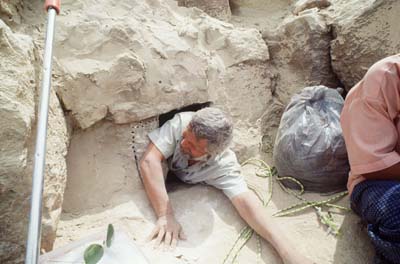
Ulrich
Kapp squeezing down through the opening of the "Mankiller"
Tunnel
at the outlet of the upper northern shaft.
The tunnel is just
big enough – about 70 by 70 cm – to allow one man to squeeze in, but it
has been filled up with about four cubic meters of sand, stones and debris,
which we have to clear out. Once that backbreaking chore is done, we refer
to the tunnel as the "Mankiller," because once anyone forces his way through
the narrow entrance, he immediately slides down to the bottom of this dark
and narrow chute, caught up in an avalanche of choking dust and stone.
Inside, there is little air to breathe but plenty of dirt and grime to
swallow.
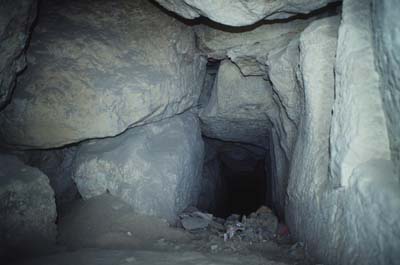
The
"Mankiller" Tunnel before we cleared out the debris and junk.
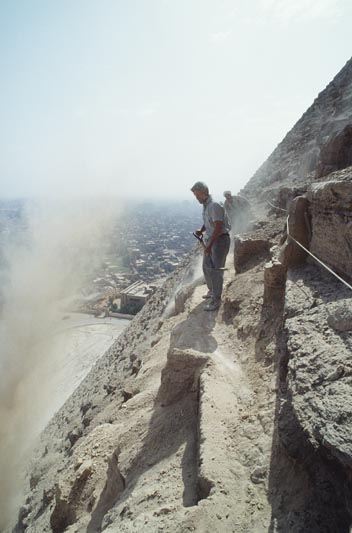
For
security reasons, before we could do any work on the
"Mankiller"
we had to clear our daily path to the site.
As we clear the tunnel
we also uncover the remains of a previous mission that had failed, probably
carried out by Petrie in 1881-82.
We find a badly-corroded,
four-wheeled vehicle which would just fit into the shaft.
It is made of solid
iron and weighs about 30 kg. The very fact that it is still up here convinces
me that an earlier attempt to clean out the shaft was made, but if failed.
If whoever tried it actually managed to pass the wheeled ram all the way
down through the shaft, he would certainly not have bothered to lug this
unwieldy beast back up to the outlet.
We discover that
the northern shaft is totally plugged, and the find of the vehicle is not
encouraging, but at least we know what we have to do. It's obvious that
larger stones are jammed in the shaft. As a result, any attempt to push
the blockage down from the top will simply compact the debris further,
jamming the shaft even more effectively.
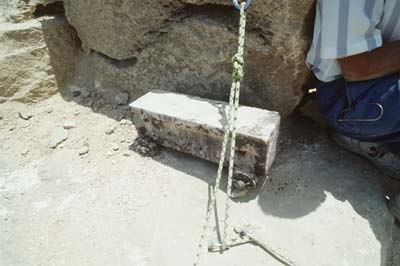
The
"battering ram" probably left behind by Petrie.
May 5th
We fashion our own,
hopefully more effective ram by sharpening one end of a truck axle and
welding a large chisel onto it. We carry this 40-kilogram construction
up to the entrance to the Mankiller.
There we attach a
rope to the rear end of our improvised ram and then send it sliding down
the chute. It accelerates for a few seconds and then crashes into the plug
of debris, with the desired effect of breaking up the larger stones into
smaller pieces, some of which slide down the shaft. But once is not enough.
Only on our third
run do we achieve our breakthrough, and hundreds of kilos dust and debris,
surrounding our axle, pour down in the Caviglia Tunnel. The interior of
the Pyramid is clouded with dust for several hours – but for the first
time in at least hundreds of years, the upper northern shaft is clear.
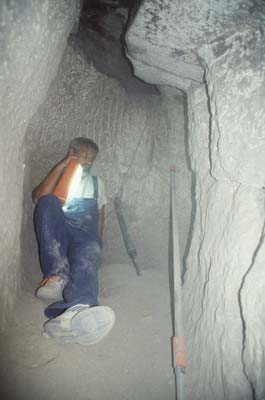
Ulrich
Kapp at the end of the Caviglia Tunnel 
after
we broke through the rubble in the shaft.
The
remains of the original shaft can be seen
at
the top.
May 6th
We are now ready
to make our first attempt to pull UPUAUT-1
up through the northern shaft. We remove the rope from the axle-ram and
attach it to the towline – heavy-duty nylon fishing line – of the robot,
and then pull the rope back up to the outlet. Then we attach the robot
at the bottom end, and begin pulling it up.
But there is still
too much sand and gravel in the shaft and the small robot sledge bogs down.
The tension on the towline increases until finally it snaps. The sledge,
along with another mass of dust, sand and gravel tumbles down to the bottom
of the shaft, landing in the Caviglia Tunnel. Luckily the sledge suffers
only minor damage.
May 7th
Sandstorm! As immensely
valuable time passes I can do nothing but twiddle my thumbs and grit my
teeth.
May 8th
We begin by again
clearing debris – and a new load of sand left by the storm – out of the
shaft and the Caviglia Tunnel.
We fit the "Mankiller"
tunnel with a 12 meter long plastic water pipe, which extends outside the
upper opening. Then we close up the tunnel with masonry to prevent stones
from falling into the shaft.
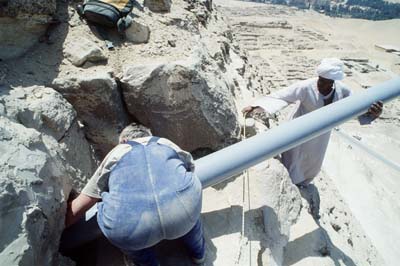
Wrestling
4-meter sections of plastic pipe 80 meters up the
pyramid's
flank is a tricky job.
(At the southern
side, we solve this problem by mounting a steel roof over the outlet. The
dangerous work on the outside of the pyramid, preparing the ground for
the ventilation, requires a total of two weeks.)
Once our clean-up
operation is completed we can finally make our next attempt to carry out
a full video inspection of the shaft with the towing sledge.
May 9th
Our second attempt
succeeds! Upuaut-1 covers the entire shaft, from the Caviglia Tunnel at
the bottom to the outlet at the top. We measure all the internal joints
of the blocks along the way, but discover nothing exceptional. At least
we experience no major difficulties. Except of course for the endless jaunts
up and down the outer face and in and out of the pyramid – for want of
a forgotten pen, or a measuring instrument, or a notebook, etc.
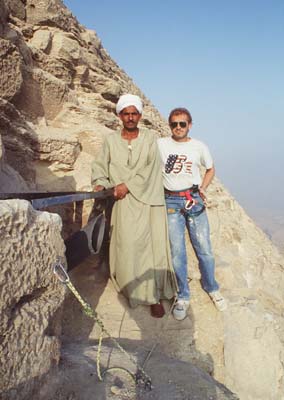
Mohammed
and I, proudly, at the finished outlet
of
the upper northern shaft.
May 10th
We install metal
bars to protect the end of the pipe at the outlet of the upper northern
shaft. We also install the electrical wiring from the exterior to the interior
of the pyramid, and the electric control panel in preparation for the ventilation
system. And we have to re-survey Caviglia Tunnel because we lost the piece
of paper with our original measurements somewhere in the dark tunnels.
May 11th
We built the roof
over the outlet of the upper southern shaft . 
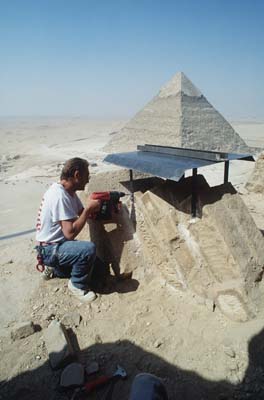
I attach
the roof to the non-original stones at
the
outlet of the upper southern shaft.
May 12th
We shift to the
upper southern shaft and successfully complete the first video inspection
of the full shaft, also measuring all the joints.
We establish that
both the upper northern and southern shafts have bends in their length
axis. This effectively disproves Robert Bauval's "Orion theory." The openings
of the shafts are not in line, in other words, from the bird's eye view,
they are not parallel to the N-S axis.
(see theBENDS
3D drawing at the CYBER
DRAWINGS page for details)
And there's a very
special surprise awaiting us in the upper southern shaft.  5.9 meters before it reaches the outside the pyramid, the shaft features
an arrangement of small niches, like recesses in the wall.
5.9 meters before it reaches the outside the pyramid, the shaft features
an arrangement of small niches, like recesses in the wall.
(see theCHEOPS
NICHES drawing at the CYBER
DRAWINGS page for details)
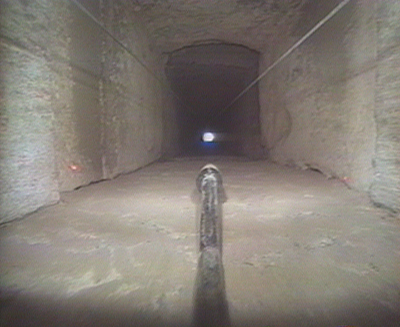
The
niches on both walls of the shaft.
In
the center you see the dusty laser rod of UPUAUT-1.
The
two laser dots are beamed on the recesses of the niches.
May 13th
I show the video
of yesterday's shaft inspection to Dr. Hawass, who is delighted and encouraging.
But he remains skeptical about the prospect of improving ventilation in
the pyramid.
I modify the camera
on the robot to give us a side-view arrangement, so we can inspect those
niches more closely.
May 14th
We conduct a thorough
video inspection of the niches on both sides of the upper end of the upper
southern shaft.
May 15th
I spend the day
chasing all over Cairo to buy the material needed to refurbish the Caviglia
Tunnel. 
May 16th
The ventilators
from Germany arrive in Cairo. We are busy constructing the brick wall in
the Caviglia Tunnel to fit in the large, two-stage ventilator. We also
modify the entrance to the service shaft to improve ventilation.
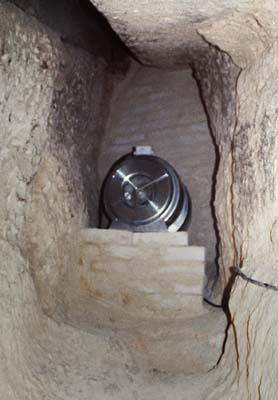
The
ventilator we installed inside the
Caviglia
Tunnel.
May 17th
We install the ventilators
and the necessary electrical equipment and fittings.
We also survey the
exterior of the pyramid, hoping to pinpoint the potential outlets of the
lower shafts. My computer analysis indicates that, if they penetrate to
the outside, they should do so near the 90th layer. Despite some dangerous
climbing and several hours of careful searching from the 80th to 101st
layers, we find no sign of any such outlets. For me, this is one
of the most intriguing findings of the campaign, because it means that
enormous effort went into constructing the lower shafts in such a way as
to remain for all time invisible.
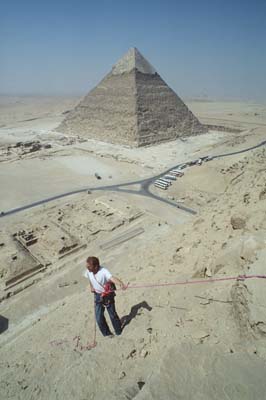
I go
searching for a possible outlet of the
lower
southern shaft. 
May 18th
We spend the day
working on the ventilation system, conducting operational tests.
None of this does
any harm to the original structures. I have used a technology to fit in
the ventilators without drilling a single hole. We have to attach specially-made,
stainless-steel anchors for the security rope. I am forced to guarantee,
as the man responsible, that there is absolutely no risk of potentially
fatal accidents.
Our test of the new
ventilation system is supervised by the still skeptical Egyptian authorities
in the person of Mostafa Abd El-Kader Eissa, Director Restoration / Conservation
of the Giza Plateau, and three inspectors.
Today's test results:
full speed – reduce
humidity from 79% to 65% in 30 minutes. Ventilators continue running overnight.
May 19th
Test results:
30% speed. At 12
o clock, 53% humidity – matching the atmospheric value outside the pyramid
for the first time in who knows how long!
May 20th
Test results:
30% speed. At 12
o clock, 53% humidity.
May 21st
Test results:
53% humidity.
May 22nd
Test results:
53% humidity. At
only 30% of capacity, the new system stabilizes and maintains the atmospheric
humidity level!
Prof. Stadelmann
urges Ulrich Kapp and me to write up a statement for the press, which we
are happy to do. After all, we are very pleased with and proud of our accomplishments.
In a very short period
of time we have helped save one of the most important monuments in the
world from further damage by humidity. We have also inspected and measured
about 120 meters of previously unknown area in the shafts, and have discovered
a hitherto unknown element - the niche in the upper southern shaft. We
have thus demonstrated that with high-tech, it is possible to explore areas
previously regarded as totally inaccessible.
A press conference
is scheduled for Saturday 23, my last day in Cairo.
May 23rd
On this Saturday
morning I receive a call from Mostafa Abd El-Kader Eissa, who tells me
that the press conference has been canceled. He says he does not know why.
Bewildered and frustrated,
I pack up and return to Germany.
|
![]() navigation button
navigation button
